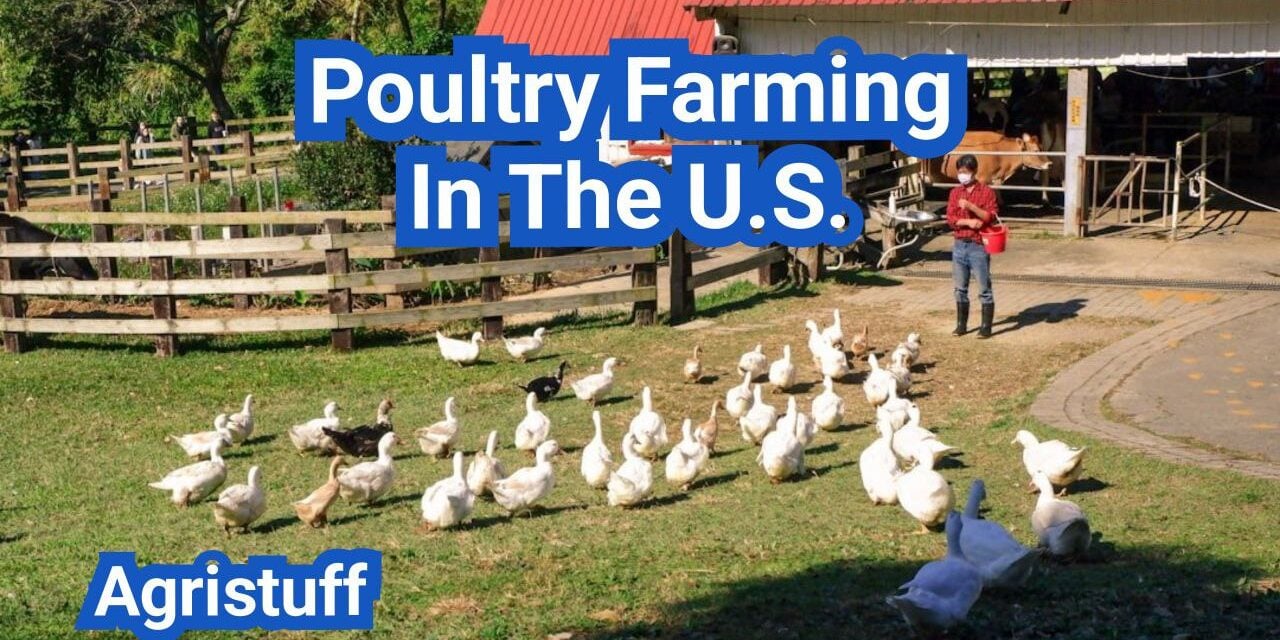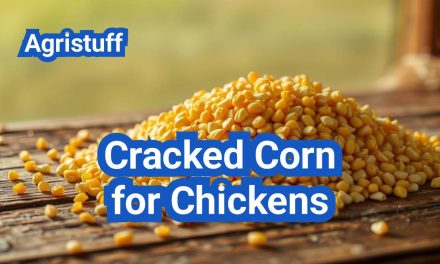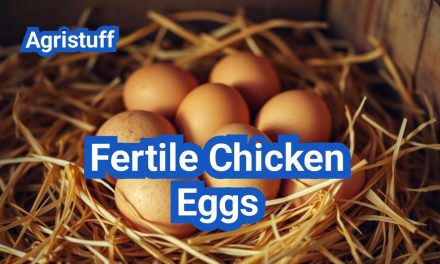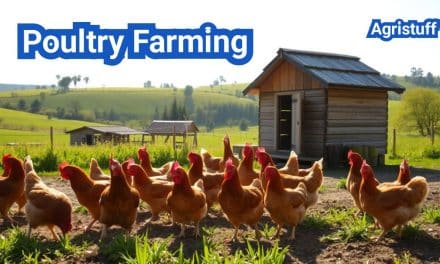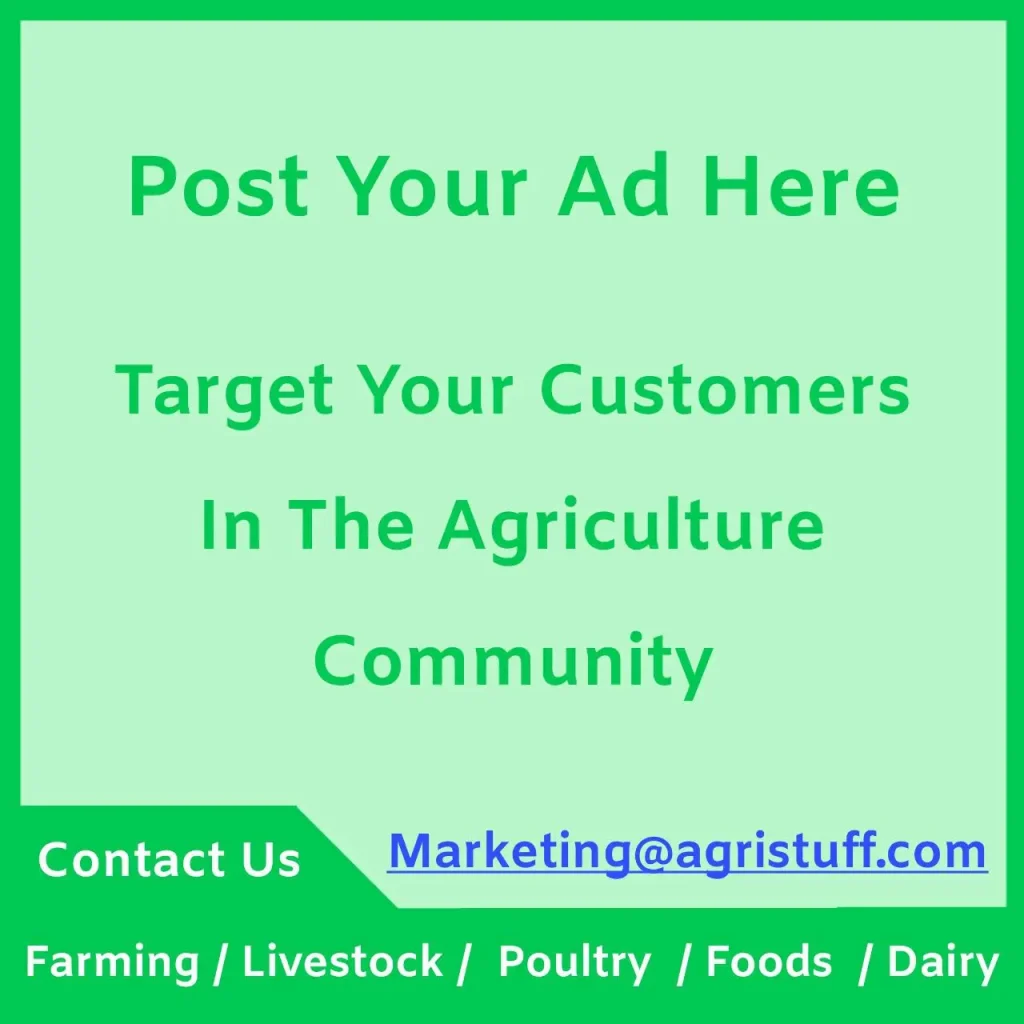The United States is one of the world’s largest producers of poultry, with chicken being the most consumed protein. According to the National Chicken Council, Americans consume about 101.2 pounds of chicken per person annually. This significant consumption rate underscores the importance of the U.S. poultry industry in meeting the country’s food demands.
The poultry farming sector plays a crucial role in the U.S. economy, with a complex network of farms, processing plants, and distribution channels. As a comprehensive guide, this article will delve into the intricacies of poultry farming in the U.S., covering key aspects such as production levels, industry trends, and best practices.
Key Takeaways
- The U.S. is a leading producer of poultry worldwide.
- Chicken consumption in the U.S. is significantly high.
- The poultry farming industry is complex and multifaceted.
- This guide will cover production levels, trends, and best practices.
- The U.S. poultry industry plays a vital role in the economy.
The Current State of Poultry Farming In The U.S.
The current state of poultry farming in the U.S. is characterized by its considerable size and economic influence. As a significant sector of the agricultural economy, it contributes substantially to the country’s GDP and provides employment to thousands.
Industry Size and Economic Impact
The U.S. poultry industry is a multi-billion dollar market. In 2023, the combined value of production from broilers, eggs, turkeys, and the value of sales from chickens was $67.1 billion. This figure underscores the industry’s substantial economic impact, not only in terms of production value but also in job creation and support for related industries such as feed production and equipment manufacturing.
Key Economic Contributions:
- Employment: Direct and indirect employment to thousands in farming, processing, and related sectors.
- GDP Contribution: Significant contribution to the national GDP through production and sales.
- Related Industries: Support for industries like feed mills, equipment manufacturers, and veterinary services.
Major Production Regions
Poultry farming is not evenly distributed across the U.S.; certain regions specialize in different aspects of poultry production. For instance, Alabama and Georgia are leading producers of broilers, while Iowa is renowned for its egg production.
Regional Specializations:
- Broiler Production: States like Alabama, Georgia, and Arkansas are among the top broiler-producing states.
- Egg Production: Iowa leads the nation in egg production, followed by other significant producers like Ohio and Indiana.
- Turkey Production: Minnesota, Arkansas, and North Carolina are key players in turkey farming.
Understanding these regional specializations is crucial for stakeholders in the poultry industry, from farmers to policymakers, as it helps in planning, resource allocation, and strategic decision-making.
Types of Poultry Farming Operations

The poultry industry in the U.S. comprises multiple sectors, including broiler production, egg production, and turkey farming, among others. This diversity allows the industry to meet various consumer demands and adapt to changing market conditions.
Commercial Broiler Production
Commercial broiler production is a significant segment of the U.S. poultry industry. Most farmers produce chickens under contract with large chicken processing companies, which provide the chicks, feed, and technical support. This model allows farmers to focus on raising the birds while the companies handle marketing and distribution.
The efficiency of commercial broiler production has been enhanced by advances in genetics, nutrition, and husbandry practices. Farms are typically large, with sophisticated housing systems that control temperature, humidity, and ventilation to optimize bird health and growth.
Egg Production Facilities
Egg production is another crucial component of the U.S. poultry industry. As of 2024, the total number of egg-laying hens was estimated at 375 million across the USA. Egg production facilities range from small, free-range farms to large, intensive operations housing tens of thousands of birds.
Modern egg production facilities often employ advanced technology to manage feeding, egg collection, and waste disposal. Some farms are transitioning to cage-free or organic production systems in response to consumer preferences.
Turkey Farming
Turkey farming is a specialized sector within the poultry industry. While not as large as broiler or egg production, it remains significant, with many farms raising turkeys for both domestic consumption and export.
Turkey farming requires careful management due to the birds’ specific nutritional and health needs. Many turkey farms are integrated into large companies that control the entire production chain, from breeding to processing.
Specialty and Heritage Breeds
In addition to the major commercial sectors, there is a growing niche for specialty and heritage poultry breeds. These farms focus on producing unique or traditional breeds that often command premium prices due to their perceived quality or heritage value.
Specialty and heritage breed farming allows for diversification and can cater to niche markets, including direct-to-consumer sales through farmers’ markets or online platforms.
| Type of Operation | Characteristics | Market Focus |
|---|---|---|
| Commercial Broiler Production | Large-scale, contract farming, advanced technology | Mass market, processing companies |
| Egg Production Facilities | Range from small to large scale, varying production systems | Retail, wholesale, direct-to-consumer |
| Turkey Farming | Specialized, often integrated into large companies | Domestic consumption, export |
| Specialty and Heritage Breeds | Niche, focus on unique or traditional breeds | Niche markets, direct-to-consumer sales |
Getting Started: Planning Your Poultry Farm
The journey to a successful poultry farming operation starts with detailed planning and research. Careful planning and preparation are key to starting a successful poultry farm. A robust business plan serves as the foundation for a poultry farming operation.
Determining Your Farm’s Purpose and Scale
Before diving into poultry farming, it’s crucial to define the purpose and scale of your operation. Are you aiming to produce eggs, meat, or both? Will your farm be small-scale for local markets or large-scale for commercial distribution? Answering these questions will help you determine the resources and infrastructure you’ll need.
Key considerations when determining your farm’s purpose and scale include:
- Market demand and trends
- Available capital and resources
- Regulatory requirements
- Your expertise and experience in poultry farming
Market Research and Business Planning
Conducting thorough market research is essential for understanding the demand for your poultry products and identifying your target market. This research will inform your business plan, helping you to outline production costs, pricing, and marketing strategies.
A comprehensive business plan should include:
- Executive summary
- Market analysis
- Production plan
- Marketing and sales strategy
- Financial projections
Here’s an example of what a simple business plan outline for a poultry farm might look like:
| Section | Description |
|---|---|
| Executive Summary | Overview of your poultry farming operation |
| Market Analysis | Research on demand and competition |
| Production Plan | Details on breeding, feeding, and health management |
| Marketing and Sales | Strategies for reaching customers and selling products |
| Financial Projections | Estimates of income and expenses |
Initial Investment Requirements
Understanding the initial investment required for your poultry farm is critical for securing funding and ensuring the financial viability of your operation. The costs can vary widely depending on the scale and type of your operation.
Typical initial investment costs include:
- Land acquisition or leasing
- Construction or renovation of farm buildings
- Purchasing equipment and initial stock
- Licensing and permits
By carefully planning your poultry farm, including determining your farm’s purpose and scale, conducting market research, and understanding initial investment requirements, you can set your operation up for success.
Legal Requirements and Regulations

Navigating the regulatory environment is a critical step for poultry farmers, involving federal, state, and sometimes local regulations. Compliance with these regulations is not only mandatory but also essential for maintaining a sustainable and responsible farming operation.
Federal Regulations for Poultry Farmers
The poultry farming industry is subject to various federal regulations aimed at ensuring food safety, animal welfare, and environmental protection. Key federal agencies involved in regulating poultry farming include the FDA, USDA, and OSHA.
- FDA Regulations: The FDA plays a crucial role in ensuring the safety of poultry products. This includes regulating feed additives, veterinary drugs, and enforcing food safety standards.
- USDA Regulations: The USDA is responsible for the inspection and grading of poultry products. It also oversees the National Poultry Improvement Plan (NPIP), which aims to control and eradicate certain poultry diseases.
- OSHA Regulations: OSHA sets standards for workplace safety, including guidelines for poultry farming operations to protect workers from hazards.
State-Specific Requirements
In addition to federal regulations, poultry farmers must comply with state-specific requirements, which can vary significantly. These may include regulations on environmental impact, animal welfare, and business operations.
| State | Regulatory Agency | Key Regulations |
|---|---|---|
| California | California Department of Food and Agriculture | Strict environmental regulations, animal welfare standards |
| Texas | Texas Department of Agriculture | Regulations on poultry waste management, business licensing |
| Georgia | Georgia Department of Agriculture | Rules governing poultry farm biosecurity, disease control measures |
Organic and Specialty Certifications
For farmers interested in organic or specialty poultry production, additional certifications are required. These certifications come with their own set of regulations and standards.
- USDA Organic Certification: Requires adherence to strict guidelines on feed, living conditions, and the use of antibiotics or hormones.
- Specialty Certifications: May include labels like “free-range” or “heritage breed.” Each has specific requirements that farmers must meet to use these labels.
Understanding and complying with these regulations is crucial for the success and sustainability of poultry farming operations. By staying informed and adhering to federal, state, and certification requirements, farmers can ensure their businesses thrive while contributing to a responsible and safe food system.
Selecting the Right Poultry Breeds
Choosing the right poultry breed is crucial for the success of your farming operation. The breed you select will impact your farm’s productivity, efficiency, and profitability. With numerous breeds available, each with its unique characteristics, it’s essential to understand the different types and their suitability for your specific needs.
Commercial Meat Breeds
Commercial meat breeds are specifically bred for their growth rates and feed efficiency. These breeds are designed to reach market weight quickly, making them ideal for large-scale poultry production.
Growth Rates and Feed Efficiency
Commercial meat breeds are known for their fast growth rates, with some breeds reaching market weight in as little as 5-6 weeks. Feed efficiency is also a critical factor, as it directly affects the cost of production. Breeds with high feed efficiency convert feed into body weight more effectively, reducing overall production costs.
Common Commercial Varieties
Some of the most common commercial meat breeds include:
- Broiler chickens: Bred specifically for meat production, these chickens are known for their fast growth rates and efficient feed conversion.
- Cobb 500: A popular broiler breed known for its fast growth rate and high yield.
- ROSS 308: Another widely used broiler breed, recognized for its efficient growth and high-quality meat.
Egg-Laying Breeds
Egg-laying breeds are bred specifically for their egg production capacity. These breeds are designed to produce a high volume of eggs throughout their laying cycle.
Production Capacity
Egg-laying breeds can produce anywhere from 280 to over 300 eggs per year, depending on the breed and management practices. Factors such as nutrition, health, and housing conditions play a significant role in determining the overall production capacity.
Popular Layer Varieties
Some popular egg-laying breeds include:
- Leghorn: Known for their high egg production, Leghorns are a popular choice for commercial egg production.
- Plymouth Rock: A friendly and prolific layer, Plymouth Rocks are often used in backyard flocks.
- Red Star: A cross between a Rhode Island Red and a White Leghorn, Red Stars are known for their high egg production and hardiness.
| Breed | Egg Production (per year) | Temperament |
|---|---|---|
| Leghorn | 280-300 | Active, flighty |
| Plymouth Rock | 280-300 | Friendly, docile |
| Red Star | 300-320 | Friendly, hardy |
Dual-Purpose Breeds
Dual-purpose breeds are versatile and can be used for both meat and egg production. These breeds offer a balance between growth rate and egg production, making them suitable for small-scale or backyard farming operations.
Heritage and Specialty Breeds
Heritage and specialty breeds are often kept for their unique characteristics, such as plumage, temperament, or historical significance. While they may not be as productive as commercial breeds, they offer diversity and can be a valuable addition to a farm or backyard flock.
Essential Infrastructure Equipment for Poultry Farm

ing involves more than just raising birds; it requires a well-planned infrastructure and the right equipment to ensure the well-being of the flock and the success of the farm.
Housing Systems and Requirements
The housing system is a critical component of poultry farming, providing birds with protection from predators, harsh weather, and disease. The choice between different housing systems depends on factors such as the scale of operation, type of poultry, and market requirements.
Cage Systems vs. Free-Range
Cage systems are widely used in commercial poultry farming due to their efficiency in managing large numbers of birds. These systems can be further categorized into conventional cages and enriched or furnished cages, which provide additional space and amenities for the birds.
Free-range systems, on the other hand, allow birds to roam outdoors, providing them with more space and natural behaviors. While free-range systems are considered more humane, they require careful management to protect birds from predators and disease.
Space Requirements Per Bird
Adequate space is crucial for the health and welfare of poultry. The specific space requirements vary depending on the type of bird and the housing system. For example, broiler chickens require about 0.2 to 1 square meter per bird, while laying hens in cage systems need about 450-600 square centimeters per bird.
Feeding and Watering Systems
Efficient feeding and watering systems are essential for poultry farming, ensuring that birds receive the necessary nutrients for growth and production. These systems range from manual to automated, with the latter being more common in large-scale operations.
The design of feeding and watering systems must consider factors such as feed waste reduction, water quality, and ease of cleaning.
Climate Control and Ventilation
Climate control and ventilation are vital for maintaining a healthy environment within poultry houses. Proper ventilation helps remove moisture, ammonia, and heat, while climate control systems regulate temperature and humidity levels.
This is particularly important in regions with extreme weather conditions, as it helps prevent heat stress and maintain optimal conditions for bird growth.
Waste Management Systems
Poultry farming generates significant amounts of waste, which must be managed effectively to prevent environmental pollution and maintain farm hygiene. Waste management systems include manure collection, storage, and disposal or utilization methods.
Effective waste management not only complies with environmental regulations but also contributes to the overall sustainability of the poultry farming operation.
Step-by-Step Guide to Setting Up Your Poultry Farm

Setting up a poultry farm requires meticulous planning and execution to ensure a successful operation. This guide will walk you through the essential steps to establish a thriving poultry farm.
Site Selection and Preparation
The first step in setting up your poultry farm is selecting the right site. This involves considering several factors, including accessibility, water availability, and environmental impact. The site should be easily accessible for deliveries and personnel, have a reliable source of clean water, and be located in an area that minimizes environmental concerns.
- Assess the land for drainage and potential for flooding.
- Ensure compliance with local zoning regulations.
- Consider the proximity to other farms and potential disease transmission risks.
Building or Retrofitting Housing
Once the site is selected, the next step is to construct or retrofit housing for your poultry. This requires careful planning to meet the needs of your birds, including adequate space, ventilation, and protection from predators.
| Housing Consideration | Description |
|---|---|
| Space | Ensure enough room for birds to move comfortably. |
| Ventilation | Adequate airflow to maintain air quality and temperature. |
| Predator Protection | Secure fencing and housing to protect against predators. |
Installing Equipment and Systems
After housing is established, the next step is to install necessary equipment and systems, including feeding and watering systems, climate control, and waste management.
- Feeding and Watering Systems: Ensure easy access to food and water.
- Climate Control: Install systems to maintain optimal temperatures.
- Waste Management: Implement effective waste disposal and recycling.
Preparing for Your First Flock
Before introducing your first flock, it’s crucial to prepare the farm and staff. This includes training staff on bird care, setting up biosecurity measures, and ensuring all equipment is in working order.
- Train staff on poultry care and management.
- Implement biosecurity protocols to prevent disease.
- Conduct a dry run of daily operations to ensure readiness.
Poultry Health Management

Effective poultry health management is crucial for the success of any poultry farming operation. It involves a comprehensive approach to prevent disease, promote flock health, and ensure the overall well-being of the birds.
Common Diseases and Prevention
Poultry are susceptible to various diseases, including respiratory diseases, parasitic infections, and nutritional disorders. Understanding these common health issues is key to implementing effective prevention strategies.
Respiratory Diseases
Respiratory diseases are a significant threat to poultry health, often caused by bacteria, viruses, or environmental factors. Proper ventilation and biosecurity measures can help mitigate these risks.
Parasitic Infections
Parasites can cause significant health problems in poultry, including external parasites like mites and lice, and internal parasites such as worms. Regular monitoring and appropriate treatments are essential for controlling parasitic infections.
Nutritional Disorders
Nutritional disorders can arise from imbalances or deficiencies in the diet. Ensuring that poultry receive a balanced diet tailored to their life stage and production needs is critical for preventing these issues.
Vaccination Programs
Vaccination is a critical component of poultry health management. Developing a vaccination program tailored to the specific needs of your flock can help protect against common diseases.
Biosecurity Measures
Biosecurity measures are vital for preventing the introduction and spread of diseases within a poultry farm. This includes practices such as controlling access to the farm, using disinfectants, and implementing proper sanitation procedures.
Working with Veterinarians
Collaborating with veterinarians is an essential aspect of effective poultry health management. Veterinarians can provide valuable guidance on disease prevention, diagnosis, and treatment, helping farmers make informed decisions about their flock’s health.
By implementing these strategies, poultry farmers can significantly improve the health and productivity of their flocks, contributing to the overall success of their farming operations.
Nutrition and Feeding Practices

Understanding the nutritional needs of your poultry is fundamental to ensuring their well-being and optimizing their growth and production. Poultry require a balanced diet that includes proteins, vitamins, and minerals to maintain health and productivity.
Feed Formulation Basics
Feed formulation is a critical aspect of poultry farming, as it directly impacts the health and productivity of the birds. A well-formulated feed should provide the necessary nutrients for optimal growth and production. Proteins, vitamins, and minerals are essential components of poultry feed, and their proportions may vary depending on the type of poultry and their life stage.
Formulating feed involves understanding the nutritional requirements of your poultry and selecting ingredients that meet those needs. Common ingredients include grains like corn and wheat, protein sources such as soybean meal, and supplements like vitamins and minerals. The goal is to create a balanced diet that supports the birds’ health and productivity.
Life Stage Nutritional Requirements
Poultry have different nutritional requirements at various stages of their lives. For instance, starter feeds for young chicks are formulated to support rapid growth and development, while layer feeds for hens are designed to support egg production. Understanding these different nutritional needs is crucial for optimizing feed formulation.
- Starter feeds (0-4 weeks): High protein content for rapid growth.
- Grower feeds (4-12 weeks): Balanced nutrients for continued growth.
- Layer feeds (after 18 weeks): Formulated to support egg production.
Feed Management and Storage
Proper feed management and storage are essential to maintaining the quality and nutritional value of the feed. Feed should be stored in a dry, cool place to prevent spoilage and contamination. Regularly inspecting feed for signs of mold or pests is also crucial.
Effective feed management involves not only proper storage but also ensuring that feed is consumed fresh. Implementing a feeding schedule and monitoring feed consumption can help reduce waste and ensure that birds receive the nutrients they need.
Day-to-Day Operations in Poultry Farming

Daily management routines form the backbone of poultry farming, influencing everything from bird health to farm profitability. Effective day-to-day operations are crucial for maintaining a healthy and productive flock.
Daily Management Routines
Daily routines in poultry farming include monitoring bird health, managing feed and water, and maintaining cleanliness. Farmers must check for signs of illness or stress in the birds, ensure that feeding and watering systems are functioning properly, and keep the living areas clean to prevent disease.
Monitoring bird health involves regular inspections to identify any signs of illness or injury. This includes checking for unusual behavior, physical symptoms, or changes in appetite or water consumption.
Managing feed and water is also critical, as it directly impacts the health and productivity of the birds. Ensuring that feed is fresh and free from contaminants, and that water is clean and accessible, is essential.
Record Keeping Systems
Record keeping is a vital aspect of poultry farming, allowing farmers to track performance, identify issues, and make informed decisions. Records can include data on bird health, feed consumption, growth rates, and mortality.
- Health records: tracking vaccinations, medications, and disease incidents
- Feed and water consumption records: monitoring intake and adjusting as necessary
- Growth and production records: tracking weight gain, egg production, and other performance metrics
Accurate and detailed record keeping helps farmers to optimize their operations and improve overall efficiency.
Labor Management
Labor management is another critical component of day-to-day operations in poultry farming. Farmers must ensure that they have sufficient staff to carry out daily tasks effectively and that workers are trained in best practices.
Training and staffing are essential for maintaining a productive and safe working environment. This includes training staff on animal welfare, biosecurity measures, and equipment operation.
Sustainable Practices in Poultry Farming

Sustainability in poultry farming encompasses a range of practices aimed at reducing environmental impact while maintaining productive and profitable farming systems. As consumer awareness and regulatory pressures continue to grow, poultry farmers are increasingly adopting sustainable practices to improve their environmental stewardship and operational efficiency.
Environmental Impact Management
Effective environmental impact management is crucial for sustainable poultry farming. This involves implementing strategies to minimize waste, reduce emissions, and protect natural resources. One key approach is the use of manure management systems that convert waste into valuable resources such as fertilizer or energy.
Manure Management Strategies:
- Implementing manure composting programs
- Utilizing anaerobic digesters to produce biogas
- Adopting precision application techniques for manure as fertilizer
| Manure Management Strategy | Environmental Benefit | Economic Benefit |
|---|---|---|
| Composting | Reduces waste volume and pathogens | Creates a valuable soil amendment |
| Anaerobic Digestion | Produces renewable energy, reduces odors | Generates electricity or heat, potential for carbon credits |
| Precision Application | Minimizes nutrient runoff into waterways | Reduces fertilizer costs, improves soil health |
Energy Efficiency Measures
Improving energy efficiency is another critical aspect of sustainable poultry farming. By reducing energy consumption, farmers can lower their operating costs and decrease their carbon footprint. Simple measures include upgrading to energy-efficient lighting and ventilation systems, as well as optimizing heating and cooling systems.
Energy-saving technologies:
- LED lighting
- High-efficiency ventilation fans
- Smart climate control systems
Water Conservation Techniques
Water conservation is essential for sustainable poultry farming, as it not only saves this precious resource but also reduces the farm’s overall environmental impact. Techniques include implementing water-saving technologies and practices such as rainwater harvesting and water recycling.
Water Conservation Strategies:
- Installing low-flow drinking systems for poultry
- Implementing rainwater collection systems
- Using water-efficient cooling systems
By adopting these sustainable practices, poultry farmers can significantly reduce their environmental footprint, improve the efficiency of their operations, and contribute to a more sustainable food production system.
Marketing and Selling Your Poultry Products
The key to a thriving poultry business lies in understanding and implementing effective marketing strategies. As the poultry industry continues to grow, farmers must adapt to changing consumer demands and preferences.
Direct-to-Consumer Sales
Direct-to-consumer sales offer poultry farmers a unique opportunity to connect with customers and increase profit margins. This approach allows farmers to:
- Sell products directly at farmers’ markets or through community-supported agriculture (CSA) programs
- Build personal relationships with customers, fostering loyalty and trust
- Command higher prices for products due to the personal touch and perceived value
Wholesale and Retail Partnerships
Establishing wholesale and retail partnerships is another vital marketing strategy for poultry farmers. This involves:
- Developing relationships with local restaurants, grocery stores, and distributors
- Negotiating contracts that ensure consistent demand and fair pricing
- Ensuring product quality and consistency to meet the requirements of wholesale and retail partners
Value-Added Products
Creating value-added products is an effective way to differentiate your poultry products and attract premium prices. Examples include:
- Processed meats such as sausages, nuggets, or smoked poultry
- Ready-to-cook or ready-to-eat meals featuring poultry as the main ingredient
- Specialty products like organic or free-range poultry products
Building Your Farm Brand
Building a strong brand identity is crucial for long-term success in the poultry industry. This involves:
- Developing a unique brand story that resonates with your target audience
- Creating consistent branding across all marketing channels, including packaging and online presence
- Engaging with customers through social media and other platforms to build brand loyalty
By implementing these marketing strategies, poultry farmers can effectively promote their products, differentiate themselves from competitors, and achieve sustainable business growth.
Financial Management for Poultry Farmers
Effective financial management is the backbone of a successful poultry farming operation. It encompasses various aspects, including cost control, product pricing, and accessing capital when needed.
Cost Control Strategies
Controlling costs is crucial for maintaining profitability in poultry farming. This involves optimizing feed costs, which are typically the largest expense, and implementing efficient waste management systems.
Farmers can also reduce costs by investing in energy-efficient equipment and exploring alternative energy sources, such as solar power, to reduce utility bills.
| Cost Category | Average Cost | Cost-Saving Strategies |
|---|---|---|
| Feed | 60-70% of total costs | Optimize feed formulation, consider alternative ingredients |
| Energy | 5-10% of total costs | Invest in energy-efficient equipment, use solar power |
| Labor | 10-15% of total costs | Implement efficient labor management practices |
Pricing Your Products
Pricing poultry products correctly is vital for ensuring profitability. Farmers must consider production costs, market demand, and competitor pricing when setting prices.
Value-added products can command higher prices, providing an opportunity to increase revenue. Examples include organic or specialty poultry products.
Accessing Loans and Grants
Poultry farmers often need to access capital to expand their operations, upgrade equipment, or cover unexpected expenses. Various loan and grant programs are available to support poultry farming.
Farmers should explore government-backed loan programs, such as those offered by the USDA, and consider private lenders that specialize in agricultural financing.
At The End of: Poultry Farming In USA
Starting and managing a successful poultry farm requires careful planning, knowledge, and dedication. By following the guidelines and best practices outlined in this article, farmers can improve their chances of success in the poultry farming industry.
A summary of the key points covered in this poultry farming guide highlights the importance of thorough planning, proper management, and ongoing education. From understanding the current state of poultry farming in the U.S. to implementing sustainable practices, each aspect plays a crucial role in achieving success.
As you move forward with your poultry farming endeavors, applying the knowledge gained from this guide will be essential. This includes selecting the right poultry breeds, managing day-to-day operations effectively, and adopting financial management strategies. By doing so, you can ensure a profitable and sustainable poultry farming business.
In conclusion, this poultry farming conclusion serves as a reminder that success in the industry is achievable with the right approach. By following the summary of poultry farming guide provided, farmers can navigate the complexities of the industry and build a thriving business.
FAQ
What is the current state of poultry farming in the U.S.?
The U.S. poultry farming industry is a significant sector, with high production levels and a substantial economic impact. Major production regions include states like Arkansas, Georgia, and Alabama.
What types of poultry farming operations are there?
There are various types, including commercial broiler production, egg production facilities, turkey farming, and specialty or heritage breed farming, each with its unique characteristics and significance.
How do I plan a poultry farm?
Planning involves determining your farm’s purpose and scale, conducting market research, understanding initial investment requirements, and creating a well-thought-out a poultry farm business plan.
What are the legal requirements for poultry farming?
Poultry farmers must comply with federal and state regulations, and for some, obtaining certifications for organic and specialty productions is necessary.
How do I choose the right poultry breed for my farm?
The choice depends on factors like growth rates, production capacity, and climate adaptability. Options include commercial meat breeds, egg-laying breeds, dual-purpose breeds, and heritage or specialty breeds.
What infrastructure and equipment are essential for poultry farming?
Essential components include housing systems, feeding and watering systems, climate control, and waste management, all of which require proper design and management.
How do I set up a poultry farm?
Setting up involves site selection, housing construction or retrofitting, equipment installation, and preparation for the first flock, with careful consideration for each step.
How can I maintain poultry health?
Maintaining health involves understanding common diseases, implementing prevention strategies, vaccination programs, biosecurity measures, and working closely with veterinarians.
What are the basics of poultry nutrition?
Poultry nutrition involves feed formulation, understanding nutritional requirements at different life stages, and proper feed management and storage to ensure a balanced diet.
How do I manage day-to-day poultry farming operations?
Effective management includes daily routines, record keeping, and labor management, all of which are crucial for a successful operation.
What sustainable practices can I adopt in poultry farming?
Sustainable practices include environmental impact management, energy efficiency measures, and water conservation techniques, contributing to a more environmentally friendly operation.
How can I market and sell my poultry products?
Marketing strategies include direct-to-consumer sales, wholesale and retail partnerships, creating value-added products, and building a farm brand to effectively reach customers.
How do I manage the financial aspects of poultry farming?
Financial management involves cost control strategies, pricing products correctly, and accessing loans or grants when necessary to ensure the farm’s financial stability.
What is the importance of biosecurity in poultry farming?
Biosecurity measures are crucial in preventing disease outbreaks and maintaining the overall health of the flock.
How can I improve energy efficiency on my poultry farm?
Improving energy efficiency can be achieved through measures like using energy-efficient lighting and equipment, optimizing ventilation systems, and exploring renewable energy sources.
Conclusion of: Poultry Farming In USA
What Poultry Farming In The U.S. Covers
Poultry Farming In The U.S. includes broiler chickens, turkeys, and egg-laying hens produced across a highly efficient, biosecure, and data-driven supply chain. Producers benefit from advanced genetics, abundant corn–soy feed, and a mature distribution network serving retail, foodservice, and export markets. Understanding how Poultry Farming In The U.S. works—from hatcheries to processing—helps farmers, buyers, and consumers make informed decisions about cost, quality, and safety. USDA ERS: Poultry & Eggs overview.
Why Poultry Farming In The U.S. Matters to the Food System
Poultry Farming In The U.S. supplies a large share of America’s animal protein because chicken and turkey are affordable, versatile, and widely accepted across diets. Even when feed prices swing or disease pressure rises, integrated supply planning keeps supermarket cases and restaurants stocked. For producers, Poultry Farming In The U.S. offers scale, year-round demand, and steady cash-flow cycles. USDA ERS: Poultry/Eggs Market Outlook.
The Main Segments Inside Poultry Farming In The U.S.
Poultry Farming In The U.S. spans three big segments: broiler meat (chicken), turkey meat, and table eggs. Broilers dominate total value, turkeys fill seasonal and deli niches, and layers drive a continuous flow of eggs for retail and foodservice. Knowing which segment you serve shapes housing design, nutrition, contracts, and biosecurity plans within Poultry Farming In The U.S. ERS: Sector at a Glance.
How Vertical Integration Shapes Poultry Farming In The U.S.
Most Poultry Farming In The U.S. takes place under vertical integration and grower contracts. Integrator companies coordinate breeder flocks, hatcheries, feed mills, veterinary care, logistics, and processing; growers supply housing, labor, and on-farm execution. This design speeds tech adoption and quality control across Poultry Farming In The U.S. ERS on integration & contracts.
Hatcheries & Placements: The Front Door of Poultry Farming In The U.S.
Chick and poult supply drives throughput for Poultry Farming In The U.S. Weekly surveys track eggs set, chicks hatched, and placements—vital indicators for planning grow-outs, harvest slots, and feed purchases. Growers watch these reports to anticipate integrator schedules in Poultry Farming In The U.S. USDA NASS: Broiler Hatchery survey.
Biosecurity Is Non-Negotiable in Poultry Farming In The U.S.
Strict, daily biosecurity protects Poultry Farming In The U.S. from pathogens that can move on tires, boots, equipment, and pests. Written farm protocols, line-of-separation, controlled access, and sanitation checklists reduce risk and keep flocks productive. Everyone on the farm is responsible for biosecurity in Poultry Farming In The U.S. USDA APHIS: Defend the Flock.
Avian Influenza: A Constant Watchpoint for Poultry Farming In The U.S.
Highly Pathogenic Avian Influenza (HPAI) remains the top disease threat to Poultry Farming In The U.S. Early detection, rapid reporting, and strict movement control protect neighboring farms and regional capacity. Producers should know the clinical signs and the response protocols that safeguard Poultry Farming In The U.S. APHIS: Avian Influenza.
Housing & Environment Fundamentals in Poultry Farming In The U.S.
Well-designed housing keeps Poultry Farming In The U.S. birds in their comfort zone through precise control of temperature, humidity, air speed, and light. Modern controllers, sensors, and alarms help growers maintain feed intake and growth while safeguarding welfare and fuel use in Poultry Farming In The U.S. UGA Poultry House Environmental Management.
Litter & Ammonia Management for Poultry Farming In The U.S.
Dry, friable litter and controlled ammonia are core to flock health in Poultry Farming In The U.S. Ammonia irritates eyes and respiratory tracts, suppresses performance, and harms welfare. Proper ventilation, litter amendments, and tight houses keep levels in check across Poultry Farming In The U.S. UGA: Litter quality & performance.
Cold-Weather Ventilation in Poultry Farming In The U.S.
Winter minimum ventilation prevents moisture buildup and high ammonia in Poultry Farming In The U.S. Tight houses, correct fan cycling, and directed inlets maintain air quality without chilling birds. Seal leaks and verify static pressure to protect gains in Poultry Farming In The U.S. Mississippi State Extension: Cold-weather ventilation.
Summer Readiness & Tunnel Air in Poultry Farming In The U.S.
When heat arrives, Poultry Farming In The U.S. relies on tuned tunnel systems—pads, fans, clean shutters, and verified air speeds—to hold body temperature and feed intake. Pre-season maintenance prevents hot-weather losses and supports uniform weights in Poultry Farming In The U.S. University of Arkansas Extension: Summer tunnel checklist.
Nutrition Basics for Poultry Farming In The U.S.
Most rations in Poultry Farming In The U.S. are corn–soy based, balanced for energy, amino acids, minerals, and vitamins. Soybean meal is the standard protein benchmark; raw soybeans are never fed because anti-nutritional factors must be deactivated by heat. Sound nutrition underpins efficient Poultry Farming In The U.S. Extension: Soybean meal in poultry diets.
Medicated Feed & Veterinary Oversight in Poultry Farming In The U.S.
When medications are required, Poultry Farming In The U.S. follows FDA’s Veterinary Feed Directive (VFD): medically important antibiotics in feed require a veterinarian’s authorization, valid client–patient–relationship, and proper recordkeeping. The goal is judicious, targeted therapy within Poultry Farming In The U.S. FDA: Veterinary Feed Directive (VFD).
Antimicrobial Stewardship Trends in Poultry Farming In The U.S.
Sales of medically important antibiotics for food-animal use have fallen substantially since their 2015 peak, reflecting stewardship across Poultry Farming In The U.S. Growers and integrators emphasize prevention via vaccination, biosecurity, and management rather than routine medication in Poultry Farming In The U.S. FDA: 2023 Antimicrobials Summary.
Inspection & Federal Oversight of Poultry Farming In The U.S.
At slaughter, Poultry Farming In The U.S. products fall under continuous USDA inspection to ensure safety, wholesomeness, and correct labeling. The Poultry Products Inspection Act defines the legal framework for processed poultry and coordination with state programs, anchoring trust in Poultry Farming In The U.S. USDA FSIS: Poultry Products Inspection Act.
Consumer Food Safety Linked to Poultry Farming In The U.S.
Safe handling at home completes the chain that starts with Poultry Farming In The U.S.: keep poultry separate, avoid cross-contamination, and always cook to 165°F (74°C) measured with a food thermometer. Proper cooling and reheating protect families and protect the brand of Poultry Farming In The U.S. FSIS: Safe Minimum Internal Temperatures.
Egg Grading & Labels Within Poultry Farming In The U.S.
Table-egg producers in Poultry Farming In The U.S. use USDA grades (AA, A, B) to communicate quality; grades reflect interior and shell characteristics, not production system. Understanding grades helps retailers and consumers align expectations with products from Poultry Farming In The U.S. USDA AMS: Shell Egg Grades.
Meat-Bird Grades in Poultry Farming In The U.S.
Ready-to-cook poultry from Poultry Farming In The U.S. can carry voluntary USDA grades (A, B, C) that indicate conformation, fleshing, and freedom from defects. Grades support transparent trade and quality signaling throughout Poultry Farming In The U.S. USDA AMS: Poultry Grades & Standards.
Manure, Water, and Compliance in Poultry Farming In The U.S.
Environmental stewardship is central to Poultry Farming In The U.S. Concentrated Animal Feeding Operations (CAFOs) must manage manure and process water to protect surface and groundwater. Nutrient management plans and proper storage cut risk and costs for Poultry Farming In The U.S. EPA: AFO/CAFO regulations & guidance.
Turning By-Products Into Value in Poultry Farming In The U.S.
With the right technology, manure from Poultry Farming In The U.S. becomes a resource: fertilizer, soil amendment, or even energy via anaerobic digestion or litter-to-energy systems. Circular practices reduce inputs and improve the footprint of Poultry Farming In The U.S. EPA: Uses of Manure.
Backyard Flocks, Public Health, and Poultry Farming In The U.S.
Backyard birds are part of Poultry Farming In The U.S., but they come with zoonotic risks. Families should wash hands after contact, keep poultry gear outside the home, and supervise children—simple habits that cut Salmonella exposure while enjoying Poultry Farming In The U.S. CDC: Backyard Poultry Safety.
Animal Welfare Programs in Poultry Farming In The U.S.
Third-party–audited welfare programs and science-based guidelines support Poultry Farming In The U.S. from hatch to harvest. Audits track stocking, air quality, lighting, handling, and humane slaughter, helping farms benchmark and improve outcomes across Poultry Farming In The U.S. National Chicken Council: Broiler Welfare Guidelines.
Keeping Perspective: Markets & Planning in Poultry Farming In The U.S.
Producers in Poultry Farming In The U.S. watch monthly and annual data—hatchery placements, layer inventory, eggs per layer—to anticipate cash-flow, feed usage, and harvest timing. Aligning farm-level KPIs with these indicators builds resilience in Poultry Farming In The U.S. USDA NASS: Chickens & Eggs (Annual Summary).
Final thought
Poultry Farming In The U.S. succeeds because it blends disciplined biosecurity, precise housing, targeted veterinary oversight, and transparent grading and inspection with market intelligence. Whether you’re a grower, buyer, or consumer, focusing on these fundamentals strengthens the entire Poultry Farming In The U.S. value chain. Explore the ERS poultry hub.
Sources & References
- USDA ERS – Poultry & Eggs (overview)
- USDA ERS – Market Outlook
- USDA ERS – Sector at a Glance
- USDA NASS – Broiler Hatchery survey
- USDA NASS – Chickens & Eggs, 2024 Summary (Feb 2025)
- USDA APHIS – Defend the Flock
- USDA APHIS – Avian Influenza
- UGA – Poultry House Environmental Management
- UGA – Litter Quality & Broiler Performance
- Mississippi State Extension – Cold-Weather Ventilation
- University of Arkansas Extension – Summer Tunnel Checklist
- Extension – Soybeans in Poultry Diets
- FDA – Veterinary Feed Directive (VFD)
- FDA – 2023 Antimicrobials Sales Summary
- USDA FSIS – Poultry Products Inspection Act
- USDA FSIS – Safe Minimum Internal Temperatures
- USDA AMS – Shell Egg Grades & Standards
- USDA AMS – Poultry Grades & Standards
- EPA – AFO/CAFO Regulations
- EPA – Uses of Manure
- CDC – Backyard Poultry Safety
- NCC – Broiler Welfare Guidelines

